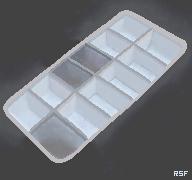
(The flashes occur whether the tray and dividers are of metal or non-metal construction.)
Installed sometime in 1997. Latest update 13 Mar 2018.
| Remove an old fashioned ice tray from a refrigerator in the dark (night time with the lights out). Let your eyes dark-adapt a few minutes before doing this. If the refrigerator light comes on while removing the tray, let your eyes re-adjust for a minute. Position the tray over a sink. (You'll need a falling-ice-cube catcher.) |

|
As you twist the tray to break the cubes loose, every one of them will
flash with a pale blue light as they pop loose. The graphic, to the left,
shows what you should see. Cubes that have already flashed, or are
yet-to-flash, are shown as dark. (The flashes occur whether the tray and dividers are of metal or non-metal construction.) |
||
|
The flash may be caused by the breaking of electrical bonds between
the ice and the tray or by a piezeoelectric effect associated with deformation
of the ice cubes with their subsequent snapping back to their original shapes.
If anybody has a good handle on explaining this process, please contact me at the address given at the bottom of this page.
According to George Nees (18 Apr 2001) this phenomenon may be a form of "piezoluminiscence." According to Alexander JJ Rice (8 Feb 2004) the phenomenon is a form of what is called "triboluminescence." Here are two links which discuss the subject. Triboluminescence - (Earth and Sky explanation, courtesy of Lewie's Fluorescent Minerals.) Triboluminescence - Eric Weisstein's World of PHYSICS. Weisstein provides explanations for two types of triboluminescence. The latter is closest to the Ice Flash phenomenon in that the nitrogen molecules of air are involved. If we are dealing with triboluminescence, instead of piezoluminiscence, then we would be concerned with the breaking of the electrical bonds between the ice and the ice tray.
Related LinksThe Kite-Acheson Effect The article, amounts to a flip-side process to the ice flash. Instead of evoking an electrical disturbance by deforming crystalline structure (ice cubes, for example), dielectric structures (desert dust and/or volcanic ash particles) may be levitated electrically, so to speak, by excess static charge on Earth's surface.
|